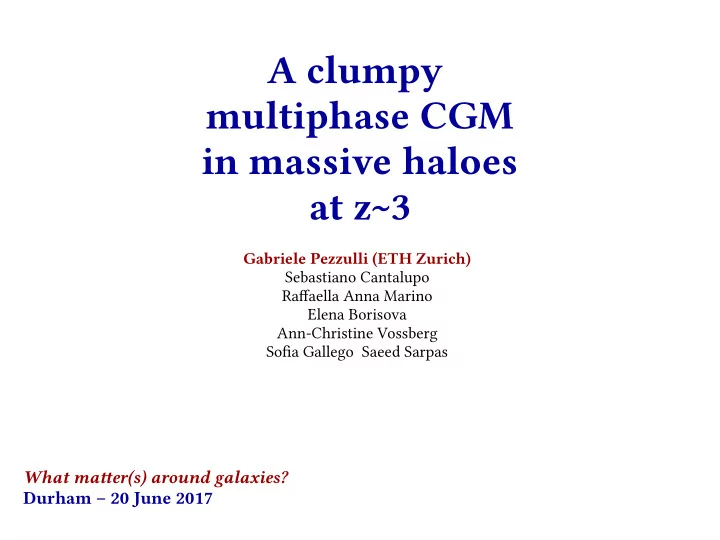

A clumpy multiphase CGM in massive haloes at z~3 Gabriele Pezzulli (ETH Zurich) Sebastiano Cantalupo Rafgaella Anna Marino Elena Borisova Ann-Christine Vossberg Sofja Gallego Saeed Sarpas What matuer(s) around galaxies? Durham – 20 June 2017
MUSE QSO Giant Lyα nebulae Borisova et al. (2016) Massive galaxy haloes at z~3 (Trainor & Steidel 2012) QSO illuminates the CGM “Cold” photoionized gas bright in recombination (Lya)
MUSE QSO Giant Lyα nebulae Borisova et al. (2016) Massive galaxy haloes at z~3 (Trainor & Steidel 2012) QSO illuminates the CGM “Cold” photoionized gas bright in recombination (Lya) What is the density distribution of the cold gas? (on large and small scales) What is its physical origin ? Is the CGM multiphase? What is the total CGM mass ?
Density profjle (large scale) Importance of small scale structure! Borisova et al. (2016) OBSERVED Surface brightness
Density profjle (large scale) Importance of small scale structure! Borisova et al. (2016) OBSERVED Surface brightness
Density profjle (large scale) Importance of small scale structure! Borisova et al. (2016) OBSERVED Surface brightness CLUMPING FACTOR
Density profjle (large scale) Importance of small scale structure! Borisova et al. (2016) OBSERVED Surface brightness CLUMPING FACTOR INTRINSIC Density profjle (volume average)
Density profjle (large scale) Importance of small scale structure! Borisova et al. (2016) OBSERVED Surface brightness CLUMPING FACTOR INTRINSIC Density profjle (volume average)
Clumpiness and mass (Trainor & Steidel 2012)
Clumpiness and mass Cfr. w. SLUG nebula (Cantalupo + 2014) (Trainor & Steidel 2012)
What is the origin of the clumpiness? Several physical scenarios, e.g.
What is the origin of the clumpiness? Several physical scenarios, e.g. ● Supersonic turbulence M = Mach number e.g. Federrath & Klessen (2013) Federrath & Klessen (2013)
What is the origin of the clumpiness? Several physical scenarios, e.g. ● Supersonic turbulence M = Mach number e.g. Federrath & Klessen (2013) Federrath & Klessen (2013) ● Spatial confjnement f V = volume fjlling factor Kritsuk & Norman (2002)
What is the origin of the clumpiness? Several physical scenarios, e.g. ● Supersonic turbulence M = Mach number e.g. Federrath & Klessen (2013) Federrath & Klessen (2013) ● Spatial confjnement f V = volume fjlling factor e.g. - gravitationally bound? - pressure confjnement by hot gas Kritsuk & Norman (2002) e.g. thermal instability (or Kelvin-Helmholtz, see Ann-Christine’s fmash talk)
What is the origin of the clumpiness? Several physical scenarios, e.g. ● Supersonic turbulence M = Mach number e.g. Federrath & Klessen (2013) Federrath & Klessen (2013) ● Spatial confjnement f V = volume fjlling factor e.g. - gravitationally bound? - pressure confjnement by hot gas Kritsuk & Norman (2002) e.g. thermal instability (or Kelvin-Helmholtz, see Ann-Christine’s fmash talk)
Properties of the cold gas Average density profjle Confjnement “ansatz” Density of the cold phase (clumps, fjlaments, sheets../)
Properties of the cold gas Average density profjle Confjnement “ansatz” Density of the cold phase (clumps, fjlaments, sheets../) Size of nebula ≈ 100 kpc Area covering factor Size of “clump” Cfr. Arrigoni-Battaia et al. (2013) + absorption (Prochaska et al. 2013) Typical size of the cold “clumps” or structures
Properties of the cold gas “thermal “ISM” instability” -like -like
Properties of the hot gas Pressure equilibrium: Filling factor:
Properties of the hot gas Pressure equilibrium: Filling factor:
Properties of the hot gas Pressure equilibrium: Filling factor:
Total CGM baryon fraction Range of plausible (consistent) clumping factor
Total CGM baryon fraction Constraints to: - star formation - ejective feedback f CGM = 50 % Minimum baryons in the CGM Range of plausible (consistent) clumping factor
Total CGM baryon fraction Constraints to: - star formation - ejective feedback Minimum baryons in the CGM f CGM = 30 - 40 % Typical “expected” value, due to ejective feedback at high z e.g. Liang et al. (2016) Mitchell, priv. comm. (EAGLE)
Total CGM baryon fraction Dependence on halo mass Constraints to: Assuming - star formation (Trainor & Steidel 2012) - ejective feedback Minimum baryons in the CGM f CGM = 30 - 40 % Typical “expected” value, due to ejective feedback at high z e.g. Liang et al. (2016) Mitchell, priv. comm. (EAGLE) (Trainor & Steidel 2012)
Total CGM baryon fraction Dependence on halo mass Constraints to: Assuming - star formation (Trainor & Steidel 2012) - ejective feedback Minimum baryons in the CGM f CGM = 30 - 40 % M halo x 3 Typical “expected” value, due to ejective feedback at high z e.g. Liang et al. (2016) Mitchell, priv. comm. (EAGLE) (Trainor & Steidel 2012)
Total CGM baryon fraction Dependence on “cold” gas temperature Constraints to: - star formation - ejective feedback Minimum baryons in the CGM T = 10^4 K f CGM = 30 - 40 % Typical “expected” value, due to ejective feedback at high z e.g. Liang et al. (2016) Mitchell, priv. comm. (EAGLE)
Total CGM baryon fraction Dependence on “cold” gas temperature Constraints to: - star formation - ejective feedback T = 2 x 10^4 K Minimum baryons in the CGM T = 10^4 K f CGM = 30 - 40 % Typical “expected” value, due to ejective feedback at high z e.g. Liang et al. (2016) Mitchell, priv. comm. (EAGLE)
Total CGM baryon fraction f CGM > 1 f CGM < 1 f CGM < 0.4 Low CGM fraction (f< 0.4) “marginally consistent” with MUSE QSO nebulae Require: - “high” halo mass (cfr. clustering & galaxy cross-correlations) - low T < 2 x 10^4 K (cfr. radiation hardness & metallicity)
Summary MUSE Giant Lyα nebulae: CGM of haloes at z ~3 ● Lyα luminosity and SB profjle imply and ● Consistent with cold gas “entrained” within a hot halo KH/thermal instability? High-res (10 pc in the CGM) required! ● CGM baryon fraction ≥ ~ 50% → Constraints to halo properties & ejective feedback Tiank you!
Recommend
More recommend